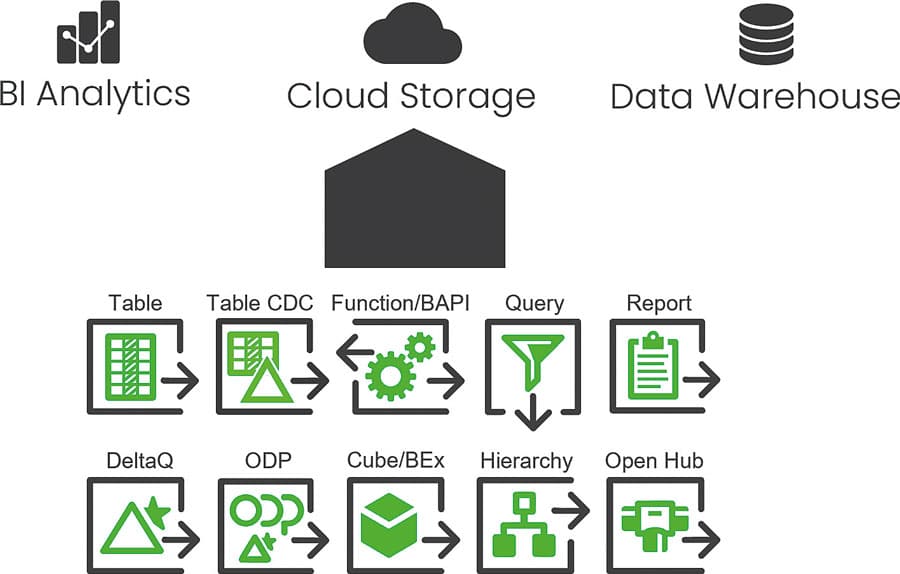SAP data in full access


SAP Cloud Integration: Leverage Data and Automate Processes on a No-Code Basis
The prerequisites for real-time and automation are suitable interfaces and connectors. The study "SAP in the midmarket" by Theobald Software shows the enormous and strongly growing relevance of cloud solutions and suitable connectors in the SAP context. For almost 39 percent of the companies surveyed, the migration of SAP systems to the cloud represents a major challenge. If SAP data is to be stored and processed in the cloud, the companies rely primarily on Amazon's public cloud infrastructure S3: With around 59 percent current and 27 percent planned use, the US company has secured first place. It shares this position with SAP's cloud infrastructure.
Cloud computing
SAP's cloud infrastructure is used by just as many companies, but only a further 19 percent have planned to do so. MS-Azure is currently lagging behind somewhat with just under 50 percent current use, but can soon look forward to high growth: around 37 percent are planning to use it. Microsoft therefore has a good chance of catching up with the current number one Amazon and even overtaking it.
The two next-placed solutions currently in use, Google Cloud Storage and Snowflake, are expected to see the highest growth rates of all: around 46 percent and 44 percent respectively are planning to use them. When it comes to connecting the SAP environment to cloud platforms, the picture is similar: Amazon leads, SAP's own cloud solutions are also very strong, and Microsoft - but here Power BI in particular, well ahead of Azure - follows closely behind. Snowflake as a cloud platform is also being planned by many companies.
For the processing and storage of SAP data, data lakes and data warehouses are currently or will be used equally intensively in the future. An important requirement of business users is central data storage (single point of truth), which is fulfilled by the installation of data lakes and data warehouses. This results in an increased need to make the data available in the cloud as well.
Sales, Controlling, HR and others: All need SAP data in their cloud target environments! Against this background, none of the companies surveyed questioned the benefits of integration software. 48 percent are already using one, 40 percent are planning to do so, and 12 percent are currently discussing it. According to the survey, more and more companies want to transfer their SAP data as completely, efficiently and quickly as possible to other cloud target environments in order to merge it there with other data, for example for monthly evaluations and forecasts in the areas of sales, controlling or HR.
Access and merging should happen without programming effort and intervention in the SAP GUI. The same increasingly applies to SAP processes: Mapping them in various cloud applications and linking them with other solutions is the basis for achieving the desired leap in automation. Achieving both goals depends on the choice of the right interface or the appropriate connector, because SAP tends to be inaccessible and shielded even after migration to the cloud.

SAP interfaces
First of all, SAP data integration. This refers to the automatic transfer of data from the SAP system (on-premises or cloud) to other target environments via interface. For example, the data is made available in different formats directly in a database. The SAP interface is supposed to perform these steps in the background without the user noticing it in everyday life. In this way, it enables fast and secure access to SAP data so that the company's individual departments can use it in their familiar target environments. Where classic development and consulting projects take weeks, months and sometimes years, the no-code approach of an independent interface shortens implementation to just a few days.
Companies can then extract the latest data for analysis at any time and integrate it into numerous desired target environments. This could be survey and procurement data deployed to the Google Cloud for reporting purposes. Or it may be raw data that is reliably transferred to the Amazon S3 Data Lake for subsequent agile forecasting of customer demand for better pricing and availability planning. For the respective departments, automation speeds up workflows enormously and errors are reduced to a minimum.
The entire application spectrum of the SAP data integrated via an independent interface is wide: management in a higher-performance database (cloud and "classic"), enrichment with information from other systems, or visualization of all business-critical data, such as target/actual comparison via a BI tool for sales or production.
SAP extractions can also be easily modified to include new data elements or to feed into other destinations. Expensive and time-consuming Abap programming is thus no longer required.
SAP process integration: Increase efficiency without programming! Meanwhile, it's no longer just about SAP data. With a cloud connector like yunIO from Theobald Software, companies can design, automate and integrate their SAP processes directly in the web browser via their familiar cloud applications. The no-code solutions connect SAP and web- or cloud-based applications and ensure that even complex process flows overcome system boundaries. It does not matter whether SAP is operated on-premises or in the cloud. Users can design processes individually as required and access data at any time via a central platform, independent of location and device, even without SAP knowledge. Typical cloud applications such as Salesforce, Nintex, Power Automate and many more can thus be connected smoothly and with low maintenance.
Master Data Management
A major advantage lies in master data management, in which SAP plays the central role. Companies must be able to rely on customer or material master data. Often, several people are involved in data maintenance and others are responsible for checking and approving changes. However, there are much more user-friendly collaborative environments for data management than SAP, such as SharePoint. The data stored and released there can be transferred to SAP automatically at the push of a button using a connector. This speeds up the process and minimizes errors during manual entry.

Another example is the creation of a business partner: Using tools such as PowerApps or Nintex, an input form can be freely designed in which the user enters the name of the partner, address and bank data, and other information. Compared to entering data in SAP using multiple input masks, the process is greatly simplified and made more user-friendly - SAP knowledge is no longer required. Once the form has been submitted, posting in SAP is fully automated within a freely selectable workflow solution.
In combination with the Microsoft Power Platform, it is also possible to automate and integrate numerous processes that today are still slow and error-prone. Examples include the automatic transfer of invoice data from a SharePoint table to SAP, a vacation request with multi-level approval, or a BANF form filled out outside of SAP and automatically forwarded.
Conclusion:
The study "SAP in the midmarket" by Theobald Software shows that SAP cloud integration is in full swing and represents a challenge for a significant proportion of companies. The market is currently still sorting itself out, with some dominant providers already established. SAP no longer has to be the closed oyster, with hard-to-extract data, complicated connectivity to external solutions and inflexible processes. Interfaces and connectors allow full no-code integration of SAP into enterprise cloud environments, even with high and ever-increasing data volumes or process complexity. In the future, the demand for networking the various enterprise solutions in the cloud will continue to increase, also because acceptance with regard to security is now widespread.
The main reason, however, is that competitiveness depends crucially on having comprehensive, data-driven analyses for strategic decisions as well as efficient processes.






